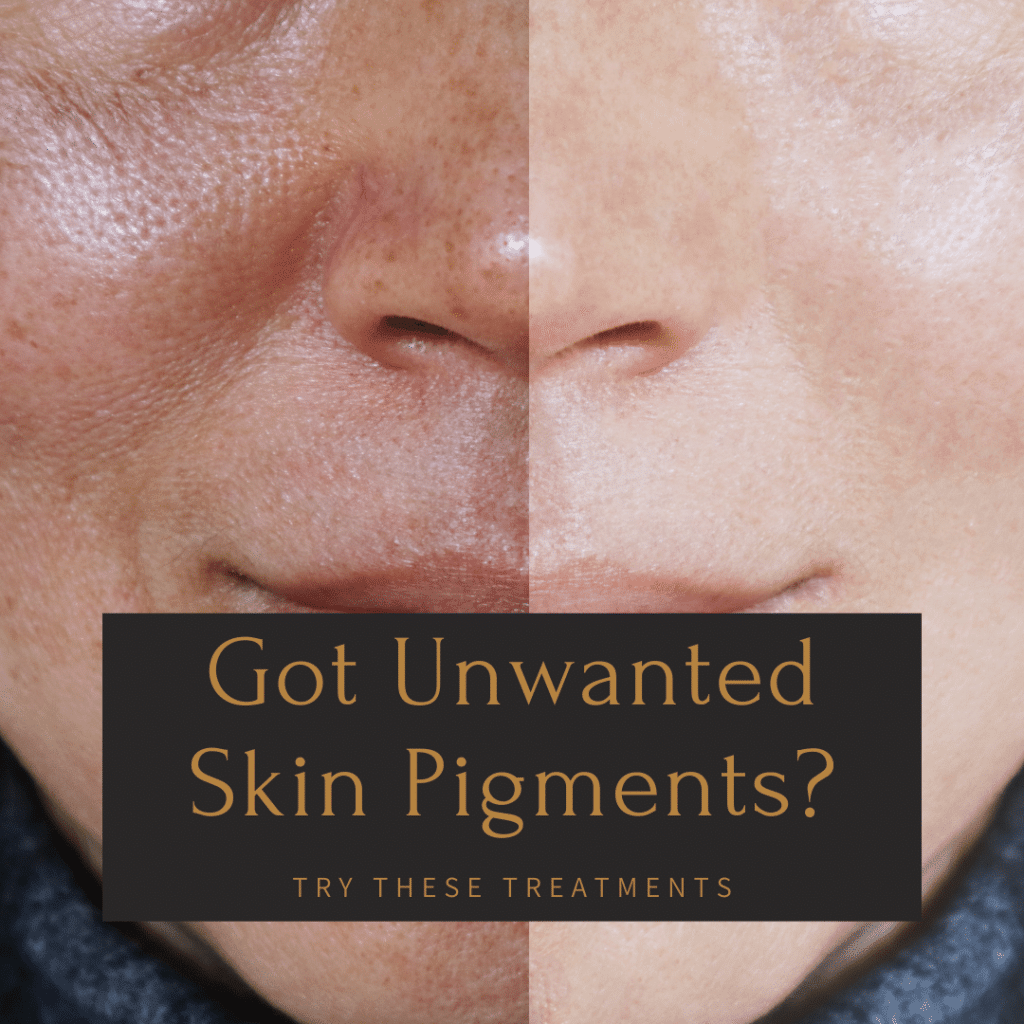Are you one of the many people who knows just how frustrating unwanted skin pigments are? You work hard to maintain a healthy lifestyle and skin care routine, only for your face to betray you with dark spots and discoloration. The good news is that there are ways to get rid of these unwanted skin pigments. In this blog post, we will discuss different types of skin pigmentations–including hyperpigmentation–and what treatments at Therapeutic Aesthetics in Toronto can help you get rid of them.
TYPES OF SKIN PIGMENTATIONS
All skin contains colored pigments known as melanin. Lighter skin contains lower amounts of melanin, while darker skin contains higher amounts. Uneven skin tone occurs when there are areas of lighter or darker pigmentation that does not match the rest of the skin. While many types of skin pigmentations are harmless, many people seek treatment as a way to decrease their appearance.
Before you start treating skin pigmentations, however, it is important to first identify the type of skin pigmentation you are dealing with. There are different types of skin pigmentations including:
Melasma: This is the most common type of skin hyperpigmentation. It typically appears as brown patches on the face, and is often triggered by sun exposure or hormonal changes.
Post-inflammatory hyperpigmentation (PIH): PIH can be caused by a number of things, including acne, eczema, psoriasis, rashes, or even injuries to the skin. This type of skin pigmentation can appear as darker or lighter spots on the skin and may not fade until several months after the initial injury occurred. Some examples can include burns, blisters, or acne scars.
Sun Damage: Sun damage can cause your skin to become darker over time. The good news is that it usually fades when you stop exposing yourself to harmful UV rays.
Liver spots/Sun Spots: Liver spots, also known as sunspots or solar lentigines, are the result of years of skin damage induced by sun exposure. These “spots” typically appear on your hands, face, or anywhere that is frequently exposed to the sun. People with fair complexions tend to experience liver spots more often than darker toned people. Birthmarks: like their name suggests, birthmarks are skin discolorations that are present at birth. Vascular birthmarks are due to abnormal blood vessels in the skin and pigmented birthmarks are due to problems with melanin in the skin. There are different types of birthmarks such as: strawberry nevus, port wine stain, salmon path, Mongolian blue spots, moles, and cafe-au-lait spots, to name a few.
WHAT YOU CAN DO TO GET RID OF UNWANTED SKIN PIGMENTATION
When it comes to getting rid of unwanted skin pigments, skin resurfacing treatments are highly effective. There are different types of skin resurfacing treatments, including:
Chemical Peels
A chemical peel is a way to treat facial wrinkles, acne scars, hyperpigmentation spots, sun damage, age spots (liver & sunspots), and other blemishes on your face without having to undergo surgery or downtime. To perform a chemical peel, a chemical solution is applied to the skin which causes the top layer of skin cells to peel away. This reveals the fresh, new skin below.
Laser Resurfacing
Laser resurfacing is a treatment that uses laser energy to remove unwanted skin pigments and improve the appearance of your skin. The laser beam targets the dark spots and damages them. This causes the body to produce new skin cells that are more even in color than they were before treatment.
Radio Frequency Skin Resurfacing
Both radio frequency skin resurfacing and laser resurfacing are used to treat facial wrinkles, acne scars, hyperpigmentation spots (melasma & post-inflammatory pigmentation), sun damage, age spots (liver & sunspots), or other blemishes on the face. The difference between these two treatments is that with radio frequency treatment, the heat from radio frequency energy is delivered through a hand piece to create tiny dermal wounds that stimulate the production of collagen. The Venus Versa Skin Resurfacing System can treat all types of unwanted skin pigmentation without causing post-inflammatory hyperpigmentation, even in people with darker skin tones.
Microneedling
Microneedling is a minimally invasive treatment that uses tiny needles to create controlled micro-injuries in the skin. This causes the body to produce new collagen and elastin, which helps improve the appearance of wrinkles, scars, and hyperpigmentation.
IPL Photorejuvenation
IPL, or Intense Pulsed Light therapy, is a type of laser treatment that is used to improve the appearance of skin. It works by targeting red and brown pigments in the skin and breaking them down. This helps reduce the appearance of sun damage, age spots, and other blemishes on the skin.
IN CONCLUSION
Unwanted skin pigments can be frustrating, but luckily there are ways to improve the appearance of your skin. If you have unwanted skin pigments, there are a variety of different treatments available for your needs including chemical peels, laser resurfacing, radio frequency skin resurfacing, and IPL photorejuvenation. Furthermore, the Venus Versa Skin Resurfacing System is the only skin resurfacing treatment that can safely treat all types of unwanted skin pigments without causing post-inflammatory hyperpigmentation in people with darker skin tones. If you need help finding an effective treatment to get rid of your unwanted pigmentations or if you want more information about any of these procedures, please contact us today at Therapeutic Aesthetics in Pickering for a free consultation.

